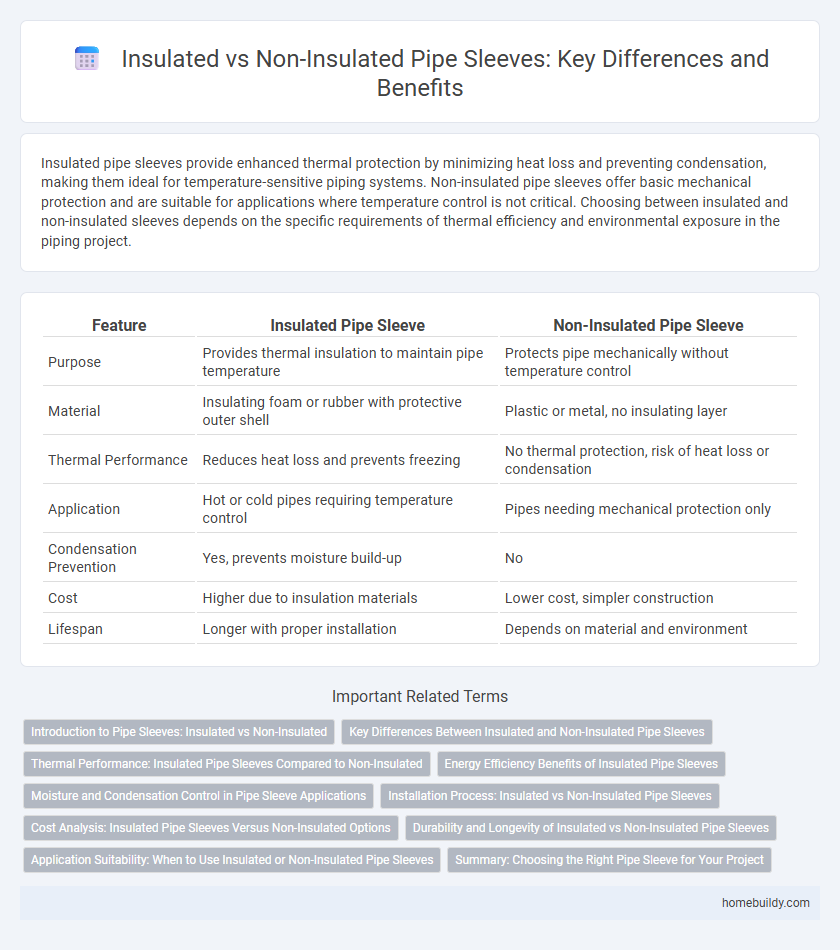Insulated pipe sleeves provide enhanced thermal protection by minimizing heat loss and preventing condensation, making them ideal for temperature-sensitive piping systems. Non-insulated pipe sleeves offer basic mechanical protection and are suitable for applications where temperature control is not critical. Choosing between insulated and non-insulated sleeves depends on the specific requirements of thermal efficiency and environmental exposure in the piping project.
Table of Comparison
| Feature | Insulated Pipe Sleeve | Non-Insulated Pipe Sleeve |
|---|---|---|
| Purpose | Provides thermal insulation to maintain pipe temperature | Protects pipe mechanically without temperature control |
| Material | Insulating foam or rubber with protective outer shell | Plastic or metal, no insulating layer |
| Thermal Performance | Reduces heat loss and prevents freezing | No thermal protection, risk of heat loss or condensation |
| Application | Hot or cold pipes requiring temperature control | Pipes needing mechanical protection only |
| Condensation Prevention | Yes, prevents moisture build-up | No |
| Cost | Higher due to insulation materials | Lower cost, simpler construction |
| Lifespan | Longer with proper installation | Depends on material and environment |
Introduction to Pipe Sleeves: Insulated vs Non-Insulated
Pipe sleeves protect pipelines from physical damage and environmental factors, with insulated pipe sleeves providing thermal insulation to reduce heat loss and prevent condensation. Non-insulated pipe sleeves primarily offer mechanical protection and ease of installation without influencing temperature control. Choosing between insulated and non-insulated sleeves depends on the specific application requirements, such as temperature maintenance, moisture control, and durability.
Key Differences Between Insulated and Non-Insulated Pipe Sleeves
Insulated pipe sleeves provide thermal protection by maintaining temperature control and preventing condensation, which is critical in HVAC and refrigeration systems. Non-insulated pipe sleeves, unable to regulate temperature, are primarily used where thermal performance is not a concern, offering basic structural protection from environmental exposure and physical damage. The key differences include heat retention, prevention of energy loss, and moisture control benefits offered exclusively by insulated sleeves, making them essential for energy efficiency and corrosion prevention in critical applications.
Thermal Performance: Insulated Pipe Sleeves Compared to Non-Insulated
Insulated pipe sleeves significantly enhance thermal performance by reducing heat loss and preventing condensation, maintaining pipe temperature stability in various environmental conditions. Non-insulated pipe sleeves lack thermal resistance, leading to increased energy consumption and potential pipe damage due to temperature fluctuations. The enhanced insulation properties of insulated sleeves contribute to energy efficiency and prolonged pipe lifespan in heating and cooling systems.
Energy Efficiency Benefits of Insulated Pipe Sleeves
Insulated pipe sleeves significantly enhance energy efficiency by reducing heat loss in hot water applications and minimizing heat gain in chilled water systems, leading to lower energy consumption and operational costs. They maintain consistent fluid temperatures, which improves system performance and reduces the load on heating or cooling equipment. Compared to non-insulated pipe sleeves, insulated options offer superior thermal protection, preventing energy waste and contributing to sustainable building practices.
Moisture and Condensation Control in Pipe Sleeve Applications
Insulated pipe sleeves effectively prevent moisture buildup and condensation by maintaining surface temperatures above the dew point, reducing the risk of corrosion and mold growth. In contrast, non-insulated pipe sleeves allow temperature fluctuations that promote condensation, leading to increased moisture accumulation within the sleeve. Proper selection of insulated sleeves is crucial for controlling humidity and extending the lifespan of piping systems in HVAC, plumbing, and industrial applications.
Installation Process: Insulated vs Non-Insulated Pipe Sleeves
The installation process of insulated pipe sleeves requires careful alignment of the insulation material to prevent thermal bridging and maintain energy efficiency, often involving additional sealing and protective layers. Non-insulated pipe sleeves have a simpler installation, typically focusing on securing the sleeve around the pipe without the need for thermal barriers. Proper installation of insulated sleeves ensures reduced heat loss and condensation prevention, while non-insulated sleeves prioritize straightforward fitting and protection from physical damage.
Cost Analysis: Insulated Pipe Sleeves Versus Non-Insulated Options
Insulated pipe sleeves typically incur higher upfront costs due to added materials like foam or fiberglass insulation, which provide enhanced thermal protection and energy efficiency. Non-insulated pipe sleeves have lower initial expenses but may lead to increased long-term costs from heat loss, condensation issues, and potential pipe damage. Cost analysis must weigh the immediate savings of non-insulated sleeves against the energy savings and reduced maintenance expenses that insulated sleeves offer over the product lifecycle.
Durability and Longevity of Insulated vs Non-Insulated Pipe Sleeves
Insulated pipe sleeves enhance durability by protecting pipes from temperature fluctuations, reducing thermal expansion and contraction that cause material fatigue in non-insulated sleeves. The insulation layer also prevents condensation-related corrosion, significantly extending the lifespan of insulated pipe sleeves compared to non-insulated alternatives. Consequently, insulated pipe sleeves offer superior longevity and maintenance cost savings in environments prone to extreme temperatures or moisture exposure.
Application Suitability: When to Use Insulated or Non-Insulated Pipe Sleeves
Insulated pipe sleeves are ideal for applications requiring thermal protection, such as cold water lines, refrigeration, and HVAC systems, where temperature control prevents condensation and energy loss. Non-insulated pipe sleeves suit environments where thermal insulation is unnecessary, primarily for protection against physical damage or allowing expansion and contraction in plumbing or electrical conduit installations. Selecting between insulated and non-insulated sleeves depends on the operating temperature and environmental conditions of the piping system.
Summary: Choosing the Right Pipe Sleeve for Your Project
Insulated pipe sleeves provide thermal protection, reducing heat loss and preventing condensation, making them ideal for temperature-sensitive applications. Non-insulated pipe sleeves offer basic mechanical protection and are suitable for environments where temperature control is not critical. Selecting the right pipe sleeve depends on project requirements such as insulation needs, environmental conditions, and budget considerations to ensure optimal pipe performance and longevity.
Insulated pipe sleeve vs Non-insulated pipe sleeve Infographic

 homebuildy.com
homebuildy.com